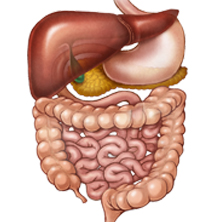Sriramavaratharajan V, Murugan R Natural Product Research, 2017 ABSTRACT: As part of our work on prospecting of Cinnamomum of the Western Ghats, chemical compositions, antioxidant, α-amylase, α-glucosidase and lipase inhibitory activities of leaf essential oil (EO) of Cinnamomum chemungianum were evaluated. Chemical characterisation of the cumin scented leaf EO from five locations in the southern Western Ghats revealed… Read more »

This system includes the mouth, teeth, tongue, esophagus, stomach, small intestine, pancreas, gallbladder, liver, large intestine, rectum and anus. Common disorders include GERD (acid reflux), indigestion, gut motility disorders, ulcerative colitis, Crohn’s disease and peptic or duodenal ulcers.
Chemical characterization, toxicology and mechanism of gastric antiulcer action of essential oil from Gallesia integrifolia (Spreng.) Harms in the in vitro and in vivo experimental models
Arunachalam K, Balogun SO, Pavan E, de Almeida GVB, de Oliveira RG, Wagner T, Cechinel Filho V, de Oliveira Martins DT Biomedicine & Pharmacotherapy, 2017 ABSTRACT: Gallesia integrifolia is a Brazilian Amazon tree whose bark decoction is popularly used to treat peptic ulcer. The essential oil from the inner stem bark of G. integrifolia (EOGi) was chemically characterized by GC/MS. The in vitro cytotoxicity… Read more »
Effects of rosemary, thyme and lemongrass oils and their major constituents on detoxifying enzyme activity and insecticidal activity in Trichoplusia ni
Tak JH, Jovel E, Isman MB Pesticide Biochemistry and Physiology, 2017 ABSTRACT: Although there have been many reports on the synergistic interactions among the major constituents of plant essential oils regarding insecticidal activity, their underlying mechanism of synergy is poorly understood. In our previous studies, we found each of the two most abundant constituents of rosemary (Rosmarinus officinalis… Read more »
A comparative study of antibacterial and anti-inflammatory effects of mouthrinse containing tea tree oil
Salvatori C, Barchi L, Guzzo F, Gargari M ORAL & Implantology, 2017 ABSTRACT: The study evaluated the antibacterial and anti-inflammatory efficacy, domiciliary oral hygiene, of a mouthrinse containing Tea Tree Oil (TTO) comparing it with two mouthrinses containing chlorhexidine 0,12% respectively and essential oils, and a placebo. MATERIALS AND METHODS: A pilot study, randomized 4 × 4, controlled, cross-over,… Read more »
Biological, medicinal and toxicological significance of Eucalyptus leaf essential oil: a review
Dhakad AK, Pandey VV, Beg S, Rawat JM Journal of the Science of Food and Agriculture, 2017 ABSTRACT: The genus Eucalyptus L’Heritier comprises about 900 species, of which more than 300 species contain volatile essential oil in their leaves. About 20 species, within these, have a high content of 1,8-cineole (more than 70 %), commercially used for the… Read more »
Inhibition of Salmonella by thyme essential oil and its effect on microbiological and sensory properties of minced pork meat packaged under vacuum and modified atmosphere
Boskovic M, Djordjevic J, Ivanovic J, Janjic J, Zdravkovic N, Glisic M, Glamoclija N, Baltic B, Djordjevic V, Baltic M International Journal of Food Microbiology, 2017 ABSTRACT: The antibacterial activity of thyme essential oil (TEO) was evaluated against four serovars of Salmonella (S. Enteritidis, S. Typhimurium, S. Montevideo and S. Infantis), experimentally inoculated (106CFU/g) in minced pork, which was treated with different concentrations of the… Read more »
Effect of cinnamon (Cinnamomum verum) bark essential oil on the halitosis-associated bacterium Solobacterium moorei and in vitro cytotoxicity
LeBel G, Haas B, Adam AA, Veilleux MP, Lagha AB, Grenier D Archives of Oral Biology, 2017 ABSTRACT: OBJECTIVES: Halitosis, also known as bad breath or oral malodour, is a condition affecting a large proportion of the population. Solobacterium moorei is a Gram-positive anaerobic bacterium that has been specifically associated with halitosis. In this study,… Read more »
Clove extract functions as a natural fatty acid synthesis inhibitor and prevents obesity in a mouse model
Ding Y, Gu Z, Wang Y, Wang S, Chen H, Zhang H, Chen W, Chen YQ Food & Function, 2017 ABSTRACT: Numerous medicinal plants have been reported to prevent various chronic diseases. In this study, we screened a new FASN inhibitor-alcohol extract of clove (AEC) using a fast microplate method developed in our laboratory. The major components of AEC were: eugenol (42.27%), acetyl eugenol (29.12%), caryophyllene (15.40%), and… Read more »
Evaluation the effect of 50 and 100 mg doses of Cuminum cyminum essential oil on glycemic indices, insulin resistance and serum inflammatory factors on patients with diabetes type II: A double-blind randomized placebo-controlled clinical trial
Jafari S, Sattari R, Ghavamzadeh S Journal of Traditional and Complementary Medicine, 2017 ABSTRACT: AIM: The purpose of this study was to evaluate the effect of 50 and 100 mg doses of green cumin essential oil on glycemic and inflammatory indices in patients with diabetes type II. METHOD: In this randomized double-blind placebo-controlled clinical trial, subjects were divided into three… Read more »
Anti-inflammatory and antialgic actions of a nanoemulsion of Rosmarinus officinalis L. essential oil and a molecular docking study of its major chemical constituents
Borges RS, Lima ES, Keita H, Ferreira IM, Fernandes CP, Cruz RAS, Duarte JL, Velázquez-Moyado J, Ortiz BLS, Castro AN, Ferreira JV, da Silva Hage-Melim LI, Carvalho JCT Inflammopharmacology, 2017 ABSTRACT: We evaluate the anti-inflammatory and antialgic potency of a nanoemulsion (NEORO) containing the essential oil of Rosmarinus officinalis L. (EORO), which is composed primarily of limonene, camphor and 1,8-cineole. The EORO and NEORO were administered orally 30 min prior… Read more »
